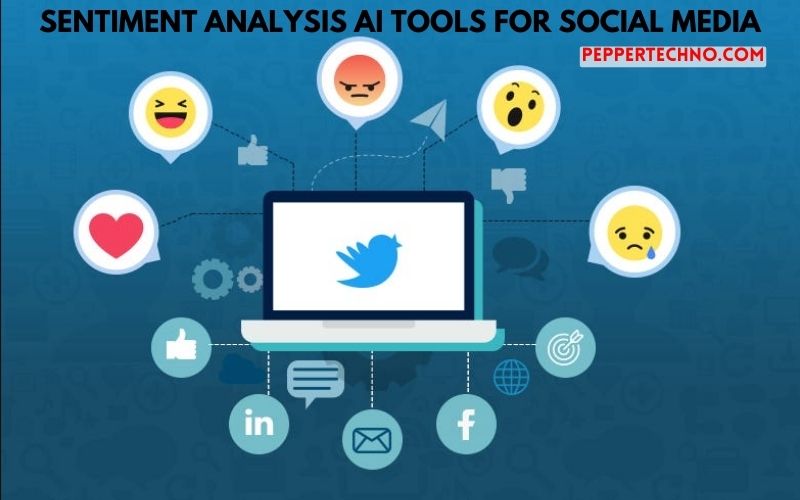Harnessing Sentiment Analysis AI Tools for Social Media Success
In today’s digitally connected world, social media platforms serve as invaluable channels for businesses to engage with their audience, build brand awareness, and drive sales. However, amidst the vast sea of social media content, understanding the sentiment of users is paramount for effective communication and decision-making. This is where sentiment analysis AI tools come into play. In this comprehensive guide, we’ll explore the significance of sentiment analysis AI tools for social media marketing and delve into the top AI tools available to empower businesses in harnessing the power of sentiment analysis.

Understanding Sentiment Analysis
Sentiment analysis, also known as opinion mining, is the process of analyzing text to determine the sentiment expressed within it. This sentiment can be positive, negative, or neutral, providing valuable insights into how users perceive a brand, product, or topic. Traditional methods of sentiment analysis relied on manual annotation or rule-based systems, which were labor-intensive and often lacked accuracy. However, with advancements in artificial intelligence and natural language processing, sentiment analysis AI tools offer scalable and precise solutions for analyzing social media content at scale.
The Importance of Sentiment Analysis in Social Media Marketing
Understanding Customer Sentiment: Sentiment analysis enables businesses to gauge the sentiment of their audience towards their brand, products, or services. By analyzing social media mentions, comments, and reviews, companies can identify trends, sentiment shifts, and areas for improvement.
Enhancing Brand Reputation: Proactively monitoring social media sentiment allows businesses to address negative feedback or complaints in a timely manner, thereby protecting and enhancing their brand reputation. By promptly responding to customer concerns, companies demonstrate their commitment to customer satisfaction and build trust among their audience.
Informing Marketing Strategies: Sentiment analysis provides valuable insights into consumer preferences, pain points, and emerging trends. By understanding the sentiment of their target audience, businesses can tailor their marketing strategies, content, and messaging to resonate with their customers effectively.
Top Sentiment Analysis AI Tools for Social Media
IBM Watson Natural Language Understanding
IBM Watson Natural Language Understanding is a powerful AI tool that offers advanced sentiment analysis capabilities. Leveraging deep learning algorithms, it can analyze text from social media posts, reviews, and articles to determine sentiment, emotion, and tone. Additionally, it provides entity recognition and keyword extraction features, enabling businesses to gain deeper insights into social media conversations.
With its user-friendly interface and robust analytics dashboard, IBM Watson Natural Language Understanding empowers businesses to track sentiment trends, identify influencers, and measure the impact of their social media campaigns.
Google Cloud Natural Language API
Google Cloud Natural Language API is another leading sentiment analysis tool that leverages machine learning to analyze text from social media and other sources. It offers sentiment analysis, entity recognition, and syntax analysis features, allowing businesses to extract valuable insights from social media data.
With its scalable infrastructure and real-time processing capabilities, Google Cloud Natural Language API enables businesses to analyze large volumes of social media content efficiently. Moreover, its integration with Google Cloud Platform facilitates seamless integration with existing workflows and applications.
Exploring Advanced Sentiment Analysis Features
Clarifai
Clarifai is an AI-powered platform that offers comprehensive sentiment analysis capabilities, particularly focused on visual content. Through cutting-edge computer vision algorithms, Clarifai can analyze images and videos shared on social media platforms to determine the sentiment conveyed through visual elements.
This advanced feature is particularly beneficial for businesses heavily reliant on visual content, such as fashion brands, food establishments, and travel companies. By understanding the sentiment evoked by images and videos, businesses can tailor their visual storytelling strategies to resonate more deeply with their audience.
Furthermore, Clarifai’s sentiment analysis can be integrated seamlessly into social media monitoring tools, providing a holistic view of sentiment across both text and visual content.
MonkeyLearn
MonkeyLearn is a versatile text analysis platform that offers customizable sentiment analysis models tailored to specific industry domains and use cases. Businesses can train their own sentiment analysis models using MonkeyLearn’s intuitive interface, incorporating industry-specific terminology and nuances to improve accuracy.
With MonkeyLearn, businesses can go beyond generic sentiment analysis and delve into more nuanced sentiment categories, such as sarcasm, irony, and sentiment towards specific topics or features. This level of granularity enables businesses to gain deeper insights into customer sentiment and tailor their social media strategies accordingly.
Additionally, MonkeyLearn offers seamless integration with popular social media platforms and marketing automation tools, allowing businesses to automate sentiment analysis workflows and derive actionable insights in real-time.
Best Practices for Integrating Sentiment Analysis into Social Media Marketing
Define Clear Objectives: Before implementing sentiment analysis AI tools, businesses should define clear objectives and key performance indicators (KPIs) for their social media marketing campaigns. Whether the goal is to monitor brand sentiment, identify customer pain points, or measure campaign effectiveness, having clarity on objectives ensures that sentiment analysis efforts are aligned with business goals.
Combine Quantitative and Qualitative Analysis: While sentiment analysis provides quantitative insights into customer sentiment, businesses should complement this with qualitative analysis to gain a deeper understanding of context and nuances. Combining quantitative metrics with qualitative insights from customer feedback, comments, and conversations allows for a more comprehensive understanding of social media sentiment.
Iterative Improvement: Sentiment analysis models require ongoing refinement and optimization to maintain accuracy and relevance. Businesses should continuously evaluate the performance of their sentiment analysis AI tools, incorporating feedback and making adjustments as needed to enhance accuracy and effectiveness.
Conclusion
Sentiment analysis AI tools offer invaluable capabilities for businesses seeking to harness the power of social media for marketing success. By understanding the sentiment of their audience, companies can make informed decisions, enhance brand reputation, and drive engagement and loyalty. With top AI tools like IBM Watson Natural Language Understanding and Google Cloud Natural Language API, businesses can unlock actionable insights from social media data, paving the way for strategic growth and competitive advantage in the digital landscape.



